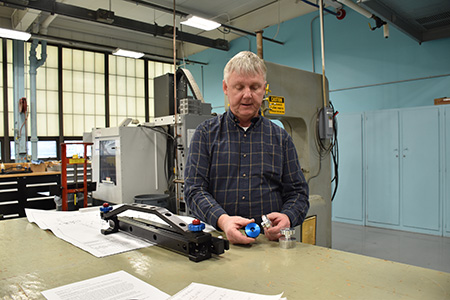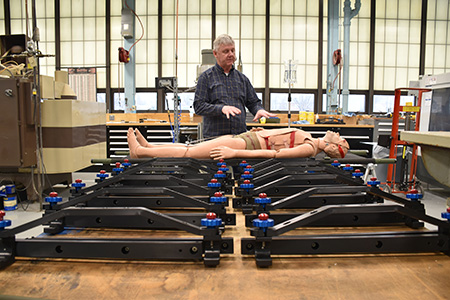SHRAIL™ Device Helps to Save Lives Far-Forward

Mark Brown, MPDL chief, explains the precise locking mechanism of the SHRAIL™ device.
(Photo courtesy of Ashley Force, USAMMDA public affairs)Saving lives is a serious business.
Fortunately, there are people across the globe called to pursue this critical effort, and many of these individuals are members of the U.S. Army Medical Command. With a mission to protect and preserve Warfighters, the U.S. Army Medical Materiel Development Activity helps to save the lives of Service Members, and civilians, each and every day. USAMMDA's Medical Prototype Development Laboratory, located at Fort Detrick, Maryland, plays a large part in accomplishing this important task, and often the solution involves a great deal of ingenuity – as evidenced by the highly innovative Sirkin-Hiles Rail System, or SHRAIL™.
Conceived by two U.S. Army surgeons, Capt. Maxwell Sirkin and Col. Jason Hiles, the SHRAIL™ medical device is a lightweight rail system that mounts to a standard NATO litter to transform it into a highly functional operating table or intensive care unit bed – anytime, anywhere.
Although stationed at the William Beaumont Army Medical Center in El Paso, Texas, the military doctors designed the product based on their various deployment experiences far-forward. The main purpose of the SHRAIL™ is to save lives in distant locations where transportation to a proper medical facility is either unavailable or unfavorable for survival.
"I've always had a desire to create something that would last and save more lives than I could ever save as one surgeon," said Sirkin.
On many occasions, he and Hiles discussed ideas on developing a breakthrough product that could exponentially save lives on the battlefield. What they kept coming back to was a device to help increase the success rate of surgical procedures in austere environments.
"Dr. Hiles spoke of his frustration during deployments, as he wasn't able to use standard surgical tools out in theater, because of the basic litter assembly," explained Sirkin. "He couldn't use a retractor, arm boards, lights and other typical surgical instruments – so those surgeons out there had to operate with less than what they had been trained to use in order to save lives."
The pair considered the problem, and they agreed that a small surgical rail on the side of a litter was what they needed to build – not only for themselves, but for every surgeon facing the same situation.
And the result turned out even better than both had anticipated.
Consisting of four anodized aluminum expandable rails with color-coded aluminum locking nuts, the highly sophisticated device appears rather simplistic at first glance. However, this "simple" device has recently been licensed by a commercial company for mass production and use in both military and civilian populations.
"The beauty of the SHRAIL™ is that it's light, 15 pounds, and compact for carrying in a backpack, so you can perform life-saving procedures right on the battlefield," said Mark Brown, MPDL chief. "It can be placed on the ground, on a table, in a vehicle – and any standard medical equipment used on an operating room table can be mounted onto the device."
Brown explained that the realization of the SHRAIL™ device is a "true team effort" by all parties involved: the inventors, USAMMDA's Medical Support Systems Project Management Office MPDL team, the U.S. Army Medical Materiel Agency, and the U.S. Army Medical Research and Materiel Command's Medical Technology Transfer Office.
Without question, the SHRAIL™ will be used to save lives – despite its humble beginnings.
"Capt. Sirkin and Col. Hiles brought us 'napkin sketches' of the concept, and we all worked together to make it into a functional prototype," said Brown. "Because of the urgency to save lives on the battlefield, they wanted it done as soon as possible, and we were able to provide a working prototype in about 10 weeks."
When asked about the challenges faced in the development of the SHRAIL™, Brown explained that form, fit and function are the typical issues they see when creating a new product. His team must adhere strictly to the requirements of the requestor, which become the "design constraints" in building the prototype from a conceptual drawing.

The functionality of the SHRAIL device is demonstrated by Mark Brown, chief of the U.S. Army Medical Materiel Development Activity's Medical Prototype Development Laboratory, Fort Detrick, Maryland. In the foreground are six SHRAIL™ device units that will be sent to far-forward military medical personnel for field testing.
(Photo courtesy of Ashley Force, USAMMDA public affairs)"For the SHRAIL™ device, we followed our typical process," said Brown. "We met with the inventors, and using a white board, we sketched out ideas – making sure we understood both the issues and the problem.
"We then took those design concepts and turned them into CAD [computer-assisted design] models, and then used a three-dimensional printer to create a physical model that we could look at in hand," he continued.
Brown stressed that, as in every situation, communication was the key to their successful results.
"We talked with each other throughout the entire process, exchanging ideas and suggestions to make sure we had what we needed," he said. "When we entered the final stage, we were already very close to the desired product, because we never allowed ourselves to go way off track at any point."
And in this case, the outcome was a groundbreaking device that can utilize the advanced capabilities of modern hospital operating room equipment in emergency scenarios anywhere in the field – which was the creators' primary goal from the very beginning.
"When we debuted the SHRAIL™ at the Military Health System Research Symposium last year, many people asked, 'Why hasn't this been invented before?'" said Sirkin. "It seemed like every doctor who had ever been deployed came over to our table and wanted one.
"[The SHRAIL™ was designed] to help the far-forward surgeon who is often hours to days from a formal operating room or hospital," he explained. "But it can also allow for operations to be done right on the patient's litter if surgical tables are already filled at the medical treatment facility."
Because the SHRAIL™ device has proven valuable for saving lives, it quickly caught the attention of commercial companies. It has been licensed to Morzine Medical LLC for manufacture and distribution in the near future.
The USAMRMC's Medical Technology Transfer Office played a key role in creating and securing the licensing agreement between the Army and Morzine Medical, as the office is tasked with coordinating all intellectual property licensing on behalf of USAMRMC's subordinate laboratories from the federal sector to nonfederal parties.
While the SHRAIL's advanced development into a marketable prototype is credited to USAMMDA's MPDL team, the MTT group was highly instrumental in helping to rapidly progress the development process and increase marketability of this critical device.
Barry Datlof, MTT director, is very pleased with the outcome of this collaborative effort, and he echoed Brown's praise of those involved. He also pointed out the importance of the licensing arrangement, which will help put the SHRAIL™ device into production soon.
"The license agreement allows for production to meet user needs, whatever these turn out to be," said Datlof. "Ultimately, there may be multiple versions of the SHRAIL™, and the commercial company was willing to license the SHRAIL™ technology and invest in further product commercialization.
"Our Assistive Technology Transfer initiative is a unique process for developing market-ready products, and this helped to reduce some of the business risk in order to encourage the company to invest in this," he continued. "Licensing a pending patent application is greatly enhanced by not only having a prototype, but also being able to specify multiple military medical needs."
Brown reiterated the importance of the license agreement, stating that it "provides the framework necessary to take this revolutionary product and make it a commercial-off-the-shelf item...with the potential to save lives on the battlefield."
"By projecting critical care medical equipment closer to the point of injury, precious time can be saved and the chance to save wounded Warfighters will be increased," he added.
The primary goal, now and always, is to save as many lives as possible, and the SHRAIL™ device seems destined to accomplish this objective – especially as it moves from limited production to worldwide distribution in the near future.
And this fact stirs quite a bit of emotion in its co-creator.
"It's surreal to think that my scrap paper drawings have been turned into something that has already been deployed and used to save lives," said Sirkin. "I couldn't ask for a better team to work with, as everyone involved is striving to produce a superior product, fixing very minor issues to improve the SHRAIL™ even further – it's an honor to be a part of this great endeavor!"













